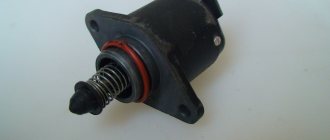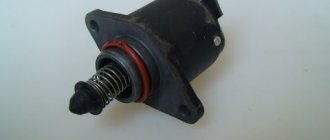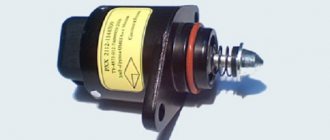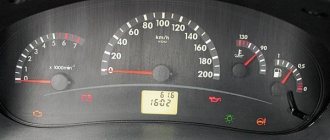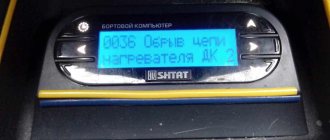The VAZ 2110 is equipped with a 1.5 and 1.6 liter injection engine. As you know, a large number of different sensors are used to operate the injector. Correct operation of the injector is achieved by accurate readings and frequency of the entire system. Often, VAZ 2110 owners are faced with the problem of floating idle speed; it is quite difficult to overcome such a reason without knowing the main reasons, and not everyone can afford to pay for expensive diagnostics.
After studying this article, you can easily find the reason for the floating idle speed on the VAZ 2110. All the reasons why the top ten does not maintain stable speed are described here in detail.
Why does the VAZ 2110 speed fluctuate?
There are several typical reasons why XX does not maintain stable speed.
- Idle air control;
- Throttle position sensor;
- Mass air flow sensor;
- Injectors;
- Filter;
- Air leak;
As you can see, there are not many reasons for this problem, but they all have a significant impact on the operation of the engine. Let's look at each of the reasons in more detail.
Idle speed control
This sensor is installed in the throttle body of the car and serves to open and close the air supply channel necessary for idling. It is a motor that operates on direct current and has a shaft with a worm gear on which a cone valve is mounted. The valve regulates the air supply in the required proportions for stable operation of the internal combustion engine at idle.
Quite often, the IAC jams, which leads to incorrect formation of the fuel mixture at idle, which is why the speed begins to float and engine operation becomes unstable. If you find such a problem on your car, you must first check the IAC.
It is also worth paying special attention to the sealing ring; it very often loses its physical properties and begins to let air through, which also leads to unstable operation of the internal combustion engine.
Damper position sensor
It is installed on the throttle assembly, like the IAC. Responsible for indicating the opening angle of the damper. If it breaks down, the idle speed can spontaneously jump to 2500 rpm and immediately drop to 500 rpm. This occurs due to rubbing of the contact part inside the sensor; this problem is “cured” by replacing the TPS with a new one, since its price is low.
Mass air flow sensor
This sensor is located on the air filter box. When it becomes dirty or aging, it quite often transmits incorrect readings to the engine control unit, which leads to unstable operation of the internal combustion engine. The cost of the sensor is steep, so it is recommended to remove the sensor from a working car and try to install it on your own.
Injectors
Injectors are quite picky about the quality of fuel; during operation, the injector sprays fuel in the required proportions. When contaminated, the injector spray becomes uneven, which leads to incorrect mixing of fuel with air and, consequently, to floating idle speed. This problem can be corrected by flushing the injectors.
Filter
Fuel and air filters directly affect engine performance. If a dirty air filter on a car can significantly reduce the power of a car engine, then chewed fuel filters lead to unstable operation of the internal combustion engine in all its operating modes. It is recommended to replace fuel filters at least once a year.
Air leak
The most extensive and problematic breakdown in a car is solved. Solving this problem is not easy due to the difficulty of detecting the source of the leak. The tightness of the car system must be absolutely everywhere. If air leaks appear somewhere that is not taken into account by the mass air flow sensor (i.e. after the sensor), this leads to unstable operation of the internal combustion engine.
You can check the car for air leaks by unscrewing the mass air flow sensor from the air filter box and turning off the air supply with the engine running. A working car should stall, and the rubber corrugation should compress and remain in a compressed position for quite a long time. If the corrugation immediately straightens out, this indicates an air leak in the system, which clearly leads to floating idle speed of the VAZ 2110.
Speed sensor
The sensor is located directly in the gearbox. One of the signs of its breakdown is unstable idle. Sometimes the engine stalls in this mode, but more often the speed fluctuates. An additional symptom is the speedometer not functioning properly.
First of all, the sensor must be checked for integrity. Be sure to consider its contacts and the wiring leading to them. Contaminants are removed, and it is better to apply Litol to the cleaned surface.
If cleaning does not help, you will have to test it. For this:
- remove the sensor;
- straighten the cable and turn the unit with the drive towards you;
- the first contact on the right on the connector is ground, the middle one goes to the speedometer, the left one supplies power (12 volts);
- clamp the drive in a screwdriver (set to unscrew);
- connect the red probe to the central wire, and ground the black probe to the body;
- start the screwdriver;
- If the multimeter shows an increase in voltage when rotating, then the sensor is working.
In this case, you should find out whether the wiring is working properly - this is another reason for floating speed. Make sure all the wires are intact, the insulation is not cracked, and there are no signs of a short circuit anywhere. At the slightest suspicion, change the cable.
Replacement
To replace the XX regulator, you do not have to be a professional. By doing the work yourself, you will gain a rewarding experience and can also save a fair amount of money.
The entire procedure must be carried out in strict sequence, which will allow everything to be done correctly and efficiently. Maybe even better than at a service station.
- Unplug your car. To do this, simply remove the negative terminal from your car's battery. We don't need short circuits or electric shocks.
- Disconnect the connector from the sensor. In the case of an injection engine installed on your VAZ 2110, to disconnect the pad you just need to press the plastic latch.
- Remove the two screws. Moreover, it is better to unscrew the left fastener first, and then the right screw.
Removing the device
- This will allow you to achieve what you want - remove the idle air control. Further operations are simple, like all previous activities.
- Before installing the new sensor in its rightful place, use regular engine oil to treat the O-ring.
- Inspect the condition of this same O-ring. During prolonged use, the seal may become deformed and become cracked. In this case, it is better to replace it with a new one.
- Next comes the calibration stage. You won’t have to make any serious efforts, since the electronic relay will take care of all the main calibration tasks.
- Turn the ignition on for a few minutes and then turn it off.
- If after the operations and calibration the revolutions stop floating, they are not increased and stable, you did everything right, and it was the XX sensor that was to blame.
As you can see, IAC is a fairly important element in the car system, which must be carefully monitored. A pleasant fact is that if troubles arise with the regulator, you can always replace it with your own hands in a matter of minutes.
Source
Checking the crankshaft position sensor
If the speed indicator on the VAZ-2110 is floating, and previous actions did not bring any results, then you need to make sure that the above sensor is working. Here too you will need a multimeter, and also a screwdriver.
Set the measuring device so that its maximum value corresponds to 200 millivolts. Connect the probes to the sensor wires (ignition is on). Bring the screwdriver closer - the multimeter will react to this by fluctuating readings. Lack of response indicates a breakdown.
Signs of breakdown
Based on certain signs, it can be determined that the IAC is out of order and needs to be repaired or completely replaced with a new device.
These signs include:
- Floating idle speed;
- Problems with starting the engine; it starts with difficulty even with the gas pedal pressed;
- It is not possible to increase the speed even when the engine has warmed up sufficiently;
- The engine suddenly begins to stall when shifting into neutral;
- The speed decreases when you turn on energy-consuming devices - stove, air conditioner, audio system, headlights, etc.
But replacing the regulator is not always the right decision. In some cases, removing the old sensor and installing a new device in its place will not bring any results. And all because the culprits of the malfunction may be other elements, such as spark plugs or a fuel filter.
Electrical system
A failure on the part of the electrical system is indicated by:
- increased fuel consumption;
- difficult starting of the engine and its unstable operation;
- tripling.
It should not be ruled out that your VAZ is faulty:
- power wiring;
- contacts in the generator;
- spark plug.
Start your inspection with the candles. The presence of soot, excessive clearance, or partial cable breakage on them increases the resistance. Failure of insulation also leads to voltage leakage. Therefore, the wires are inspected closely, paying attention to the wiring of the terminals and the contacts of the latter.
Mass air flow sensor VAZ2110, is it OK, what should you pay attention to?
Stable engine operation depends on the optimal composition of the fuel mixture. The main task of the mass air flow sensor is to achieve the correct ratio of the elements of the air-fuel mixture. If it is faulty, disturbances in the operation of the engine occur, problems with starting the engine and other troubles begin. Using a hot-wire anemometer, the air flow sensor monitors the amount of air entering the cylinders using special algorithms.
There are several signs of a damaged air flow sensor:
- Excessive consumption of fuel occurs.
- The engine starts poorly or does not start at all.
- Significant deterioration in dynamics.
- There are noticeable interruptions in the operation of the motor.
- Spontaneous increase or decrease in floating idle speed.
To check the mass air flow sensor you should:
- Turn on the multimeter.
- Then we install wires with electrodes into suitable connectors.
- We set the voltage to twenty volts.
- Next, take two pins and place them in the holes of the green and yellow MAF wires.
- Now you need to connect the multimeter electrodes to them.
- Turn on the ignition and measure the voltage using a multimeter.
- On a working mass air flow sensor, the indicator should be approximately 0.99-1.00.
Idle speed control
There are several signs that this device is broken. First of all, because of this, the revolutions fluctuate. Besides:
- the engine sometimes does not start;
- There is no power even after the engine warms up;
- When switching to neutral, the power plant stalls.
The speed fluctuates most noticeably when electrical appliances are in operation (headlights, air conditioning, radio, etc.).
However, installing a new regulator does not always correct the situation - it is for this reason that before checking it, it is necessary to cut off all the above-mentioned options without exception.
The same multimeter can help determine the reason why the speed fluctuates. Before this you should:
- disassemble the throttle mount and move it a maximum of a centimeter;
- remove the negative cable from the battery and place it on ground;
- Connect the probes of the measuring device to the outputs marked with the letters A and D.
So, if the multimeter shows less than 12 volts, then this means that the problem arose due to a low battery. A higher voltage indicates failure of the IAC resistor. In this situation, it is the resistance that should be checked. Switch the multimeter to ohms and take a measurement - the norm will be from 50 to 55.
The complete lack of data suggests that the idle speed is floating due to a broken wiring.
Source
Throttle sensor
If the TPS is faulty, then the VAZ car often begins to work unstably. The main signs of a problem include:
- floating speed at idle;
- speed reduction;
- jerky acceleration;
- sudden engine shutdown.
The sensor in question most often fails for the following reason - abrasion of the coating on the base. This prevents the signal from reaching the controller, which causes the motor to malfunction. Failure of the slider leads to a similar result. Any of these problems can be recognized visually.
Device role
On injection engines that are installed on the VAZ 2110, the XX regulator serves to control the stable operation of the power unit. It is unlikely that you will be pleasantly surprised by a situation in which the idle speed starts to fluctuate, and every now and then the car will stall.
Some people do not know about another very important role of the idle speed sensor - warming up the power unit in case of low air temperature.
It is generally accepted that if there is an injector, there is no need to warm up the engine. The opinion is wrong. Do not overstress the engine, but first let it run for a while without increased speed. This will have a positive effect on the reliability and service life of the motor. .
Location
Externally, the IAC looks quite simple. It looks like a small electric motor. Its design includes three parts:
- Stepper motor;
- Spring;
- A rod with a needle at the end.
And the desired regulator is located near the mechanism that is responsible for changing the position of the throttle valve. There is no complex fastening system. To dismantle you just need to remove the mounting bolts.
How does he work
The function of the IAC is to regulate the amount of fuel supplied. He may indicate the need to increase or decrease the quantity. An important nuance is that the sensor performs its functions directly when the idle speed is turned on.
The actual action of increasing or decreasing occurs due to the extension or retraction of the needle at the end of the rod. The needle is responsible for closing or opening the special channel to the required extent.
Learning to distinguish a fake from an original
Today, many people complain about the abundance of counterfeit products on the auto parts market.
If we talk specifically about the XX regulator for the VAZ 2110, then there are several key signs by which a fake can be distinguished from the original. Be guided by these data so as not to accidentally install a device of dubious quality and origin on your car.
Fake and original
- On fakes, the black body made of metal is 1 millimeter shorter than the real part.
- In the case of the fake, the three white rivets on the case have no heads. They must be present in the original. And the diameter of the caps is 3 millimeters.
- On fakes, the spring is made in white and has more frequent winding. In the original, the coiling is less frequent, and the spring itself is black.
- Pay attention to the rubber ring of the regulator. On fakes it is black and thin, but in the case of a real part, a reddish tint is noticeable. Plus the thickness is greater.
- Take a closer look at the tip. In fakes it is darker compared to the original spare part.
- There are no markings on the counterfeit packaging; the boxes are noticeably different in appearance.
- The original yellow sticker located on the case must have an outer frame. Manufacturers of counterfeits apparently forgot about it.
As you can see, recognizing a fake is not difficult. You just need to be more attentive to details.
The difference is in the boxes


